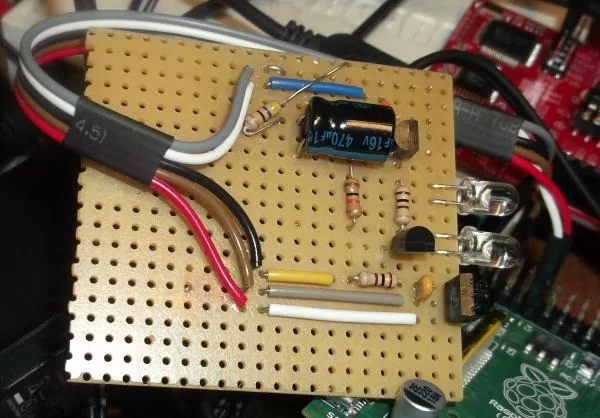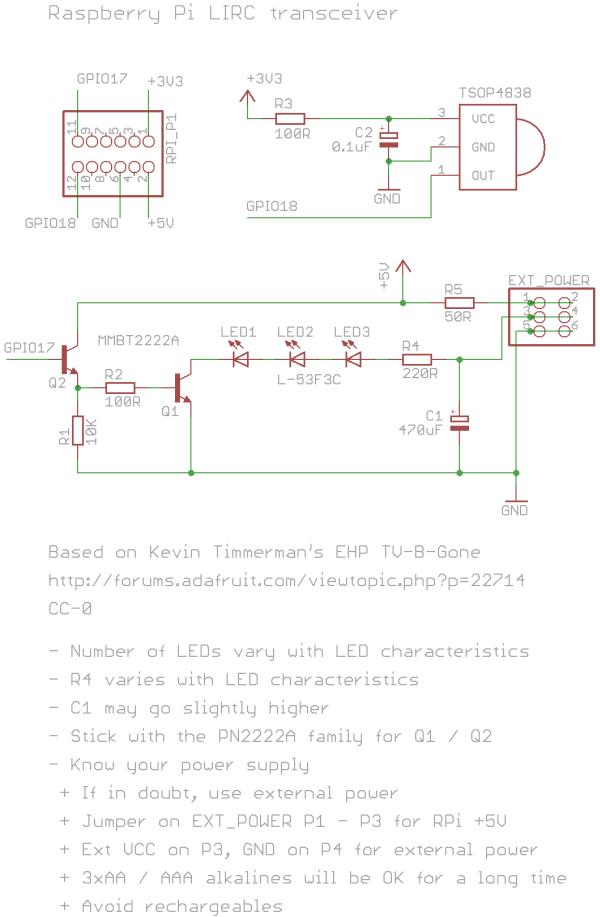The driver:
The driver is actually a modification of the lirc_serial module. I decided to create a new one separately because I couldn't hack it into the serial nor the gpio driver. The serial driver uses the DCD of the serial port, which is not implemented by the RPi. The gpio driver is created mainly to “talk” with TV tuner cards chip (here the module receives codes instead of pulse signals).
Installing the driver:
The driver is not in the main lirc repository, so the lirc sources must be patched first then the driver must be compiled. To do this you need to get the lirc sources. To compile a kernel module you need your kernel's header files.
(I didn't have the time to create a detailed HOWTO for every RPi binary distribution, so if someone could send me one I can publicate it here, so everything can be found in one place).
Howto install it on:
Recompile the kernel:
Follow the guide here. After cloning the kernel, apply the patch in its root directory:
wget http://aron.ws/projects/lirc_rpi/kernel.lirc_rpi-0.3.patch patch -p1 < kernel.lirc_rpi-0.3.patch #Add the following to .config or enable in menuconfig: CONFIG_RC_CORE=m CONFIG_LIRC=m CONFIG_RC_MAP=m CONFIG_IR_NEC_DECODER=m CONFIG_IR_RC5_DECODER=m CONFIG_IR_RC6_DECODER=m CONFIG_IR_JVC_DECODER=m CONFIG_IR_SONY_DECODER=m CONFIG_IR_RC5_SZ_DECODER=m CONFIG_IR_MCE_KBD_DECODER=m CONFIG_IR_LIRC_CODEC=m CONFIG_STAGING=y CONFIG_STAGING_MEDIA=y CONFIG_LIRC_STAGING=y CONFIG_LIRC_RPI=m
Loading the driver:
The driver has 5 parameters: debug, gpio_out_pin, gpio_in_pin, sense, softcarrier.
The default gpio input pin (PIN12 – GPIO18) is used when no input pin is specified as a parameter. The default gpio output pin for transmission is PIN11 – GPIO17. Please consult the RPi wiki page for more information about GPIO pins (here).
Example:
modprobe lirc_rpi gpio_in_pin=0 gpio_out_pin=1
The driver will use GPIO0, pin 3 on the RPi board as input.
Troubleshooting:
Check if the module could allocate the gpio pins.
mount -t debugfs debugfs /sys/kernel/debug cat /sys/kernel/debug/gpio The output should be something like this (you should see two gpio pins allocated to the lirc_rpi driver): GPIOs 0-53, bcm2708_gpio: gpio-16 (led0 ) out hi gpio-17 (lirc_rpi ir/out ) in lo gpio-18 (lirc_rpi ir/in ) in hi
Check dmesg after loading the module with the debug parameter.
modprobe lirc_rpi debug=1 lirc_dev: IR Remote Control driver registered, major 252 lirc_rpi: module is from the staging directory, the quality is unknown, you have been warned. lirc_rpi lirc_rpi.0: lirc_dev: driver lirc_rpi registered at minor = 0 lirc_rpi: driver registered! lirc_rpi: is_right_chip bcm2708_gpio 0 lirc_rpi: to_irq 103 lirc_rpi: auto-detected active low receiver on GPIO pin 18
Run irw then check if the module succesfuly requested an irq.
cat /proc/interrupts
CPU0
3: 88963 ARMCTRL BCM2708 Timer Tick
52: 3251 ARMCTRL BCM2708 GPIO catchall handler
65: 2 ARMCTRL ARM Mailbox IRQ
66: 1 ARMCTRL VCHIQ doorbell
75: 51434882 ARMCTRL dwc_otg, dwc_otg_pcd, dwc_otg_hcd:usb1
77: 223 ARMCTRL bcm2708_sdhci (dma)
83: 24 ARMCTRL uart-pl011
84: 7123 ARMCTRL mmc0
103: 3251 GPIO lirc_rpi
The hardware:
The RPi's processor uses 3.3V levels and the pins are not 5V tolerant!!!
The receiver:
Te be able to capture the IR signals I used an infrared receiver that can operate at this voltage (like TSOP 1238). The classic TSOP 17xx and 18xx are unstable at 3.3V and won't work without some kind of level converter (IC, photo diode etc.).
As the LIRC manual states: “Most of these receivers come in variations adapted to a specific carrier frequency. You should choose the 38kHz types because most remote control standards use this frequency. 36kHz types should work as well. The receiver won't stop working if your remote uses another frequency but the range will decrease.”
I would recommend these receiver modules (no test have been performed with these, but they should work…):<br\>
- TSOP2238, TSOP2438, *TSOP4838, *TSOP4438 (active high/low check the datasheet) (datasheet)
- *TSOP31238 (active low) (datasheet)
- *TSOP4038 (active low) (datasheet)
- *TSOP38238 (active low) (datasheet)
- *IRM3638N3 (datasheet)
- **TSOP1238 (active low) (datasheet)
- and many others … (send them to me if you have found and tested new ones)
* Reported as working (Thanks go to: ice, Everett, George, druss, Djuri, Peter, Hannes)
** Was manufactured (according to old datasheets) as an 5V part. Consider ordering any other (Reported by: Tom)
The “hardware” is as simple as it seems. Power the IR receiver from the GPIO and use one of the GPIO ports to pass the signal to the RPi. By default the driver uses PIN12 (GPIO18) this can be configured with the gpio_pin parameter.
For more detail: Raspberry Pi lirc_rpi – (IR Remote control) LIRC GPIO driver



